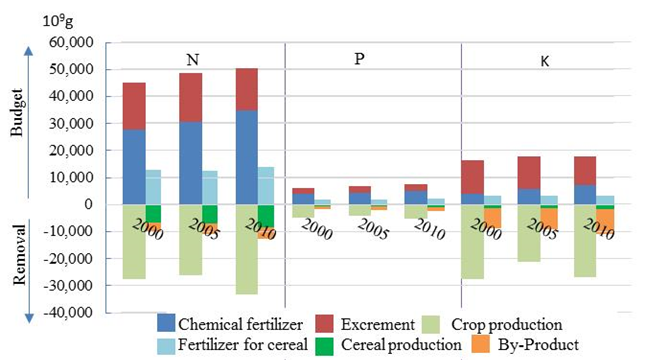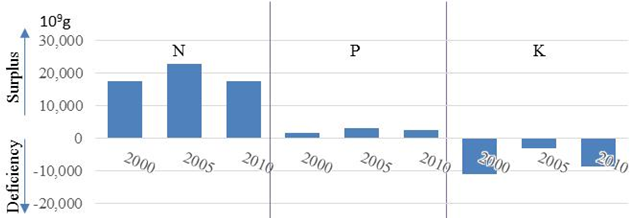Potassium deficiency in fertilizer budget for crop production in China
Description
There are several concerns about the negative environmental impact of excessive fertilizer use, especially nitrogen use, on Chinese agricultural production systems. Therefore, we calculated the nutrient intake by crops and the nutrient budget in China to obtain information on fertilizer demand and its effective use, food production, and the management of fertilizer resources from the view point of apparent nutrient (nitrogen (N), phosphorus (P) and potassium (K)) balance. Data sets on chemical fertilizer types, crop production, livestock population, and human population came from “China Agriculture Yearbook,” with 2000, 2005, and 2010 chosen as the target years. In this study, we assumed the rural population as half of total population. Basic unit values of N, P, and K excretion by human and livestock were obtained from “China Organic Fertilizer Ingredients”; N, P, and K concentration in crops were from “China Fertilizer”; and chemical fertilizer application rates for cereals were from “Fertilizer Guideline for Crops.” The budgets of chemical N and P fertilizers are larger than that of chemical K but smaller than that of organic fertilizers. Also, based on the output or crop yield, K output of cereal by-products (stems and leaves) occupies a significant portion of total K output. The apparent N, P, and K balance shows a large surplus of N, an even amount of P, and a deficiency of K. For K, the crop K output was larger than the K budget; therefore, it is believed that the K deficiency will reduce soil K fertility. The cereal K output includes by-products, leaving the farmland soil largely deficient in K fertilizer. However, if only the product part is removed and the by-products returned to the soil, then the amount of N, P, and K would be enough. Therefore, K deficiency for cereal will disappear when the by-product is sown back into the soil or used for mulching. In this study, basic units of excretion, crop N-P-K contents, and statistical data were entered into a Microsoft Excel spreadsheet so the apparent nutrient balance in each province can be calculated. The results can be used for the effective management of fertilizer resources and for policy-making. On the other hand, we did not calculate the loss of N, P, and K during storage and composting and during volatilization of N when N was applied to alkali soils. We may incorporate these factors in future studies to obtain a more accurate balance measurement and a quantitative assessment of its environmental impact.
Figure, table
-
Figure1. Nutrient budget and removal
-
Figure 2. Apparent N, P, and K balance for all crops
-
Figure 3. Nutrient balance for cereals without by-product removal
- Affiliation
-
Japan International Research Center for Agricultural Sciences Social Sciences Division
- Classification
-
Administration B
- Program name
- Term of research
-
FY 2013 (FY 2011-FY 2013)
- Responsible researcher
-
Mishima Shinichiro ( National Institute for Agro-Environmental Sciences )
Hsiaoping Chien ( Social Sciences Division )
- ほか
- Publication, etc.
-
Mishima,S. et al. (2013) Recent advances in Chinese agricultural production and its sustainability. BIT’s annual world congress of agriculture:141
Li H, et al. (2013) Chinese journal of soil Science, Vol.44, No.6:1428-1433
- Japanese PDF
-
2013_C04_A3_ja.pdf326.64 KB
2013_C04_A4_ja.pdf293.95 KB
- English PDF
-
2013_C04_A3_en.pdf249.46 KB
2013_C04_A4_en.pdf180.09 KB



